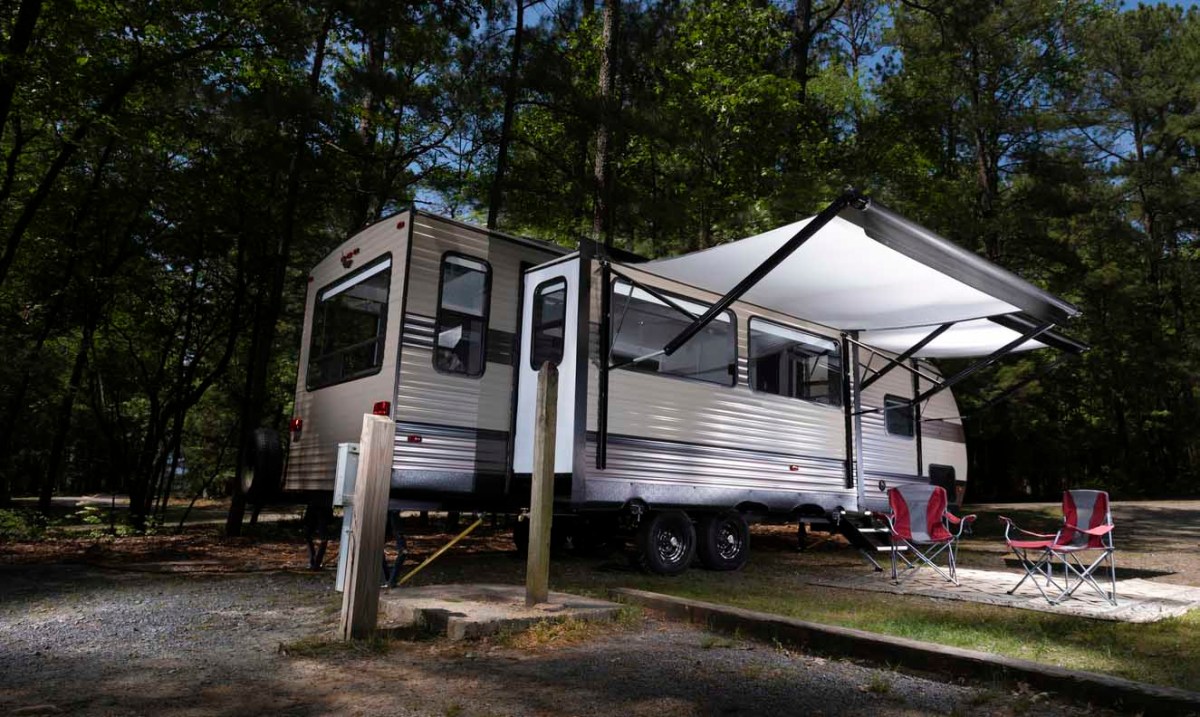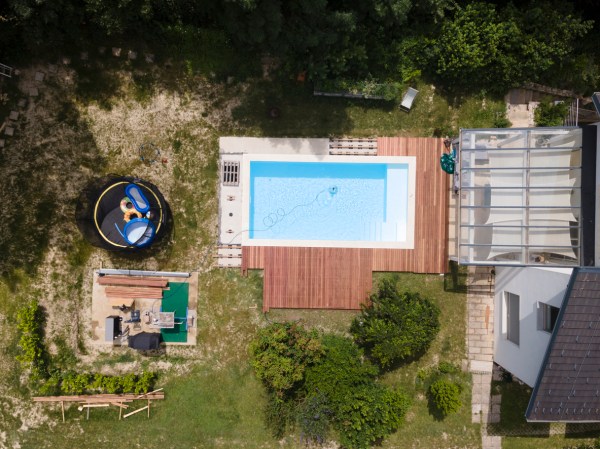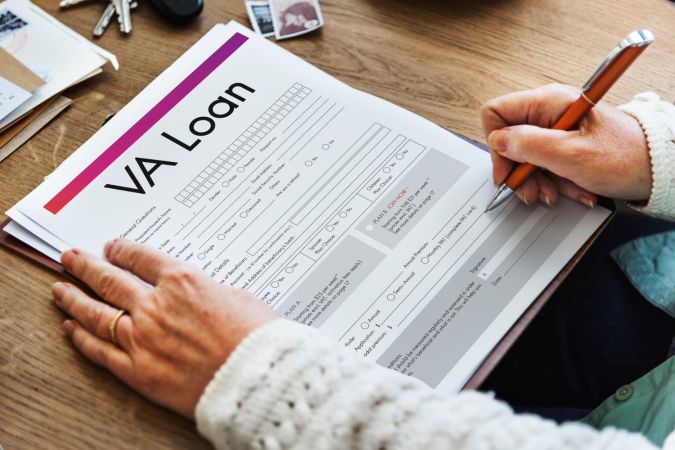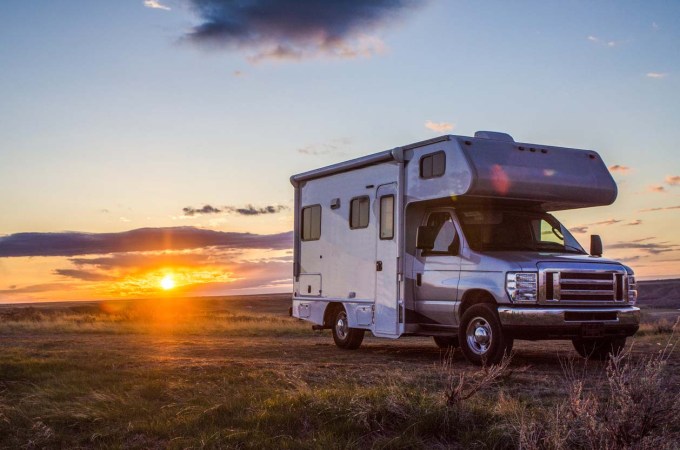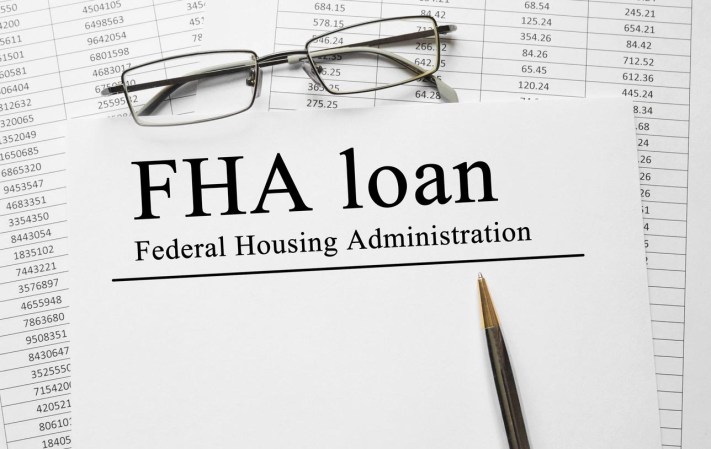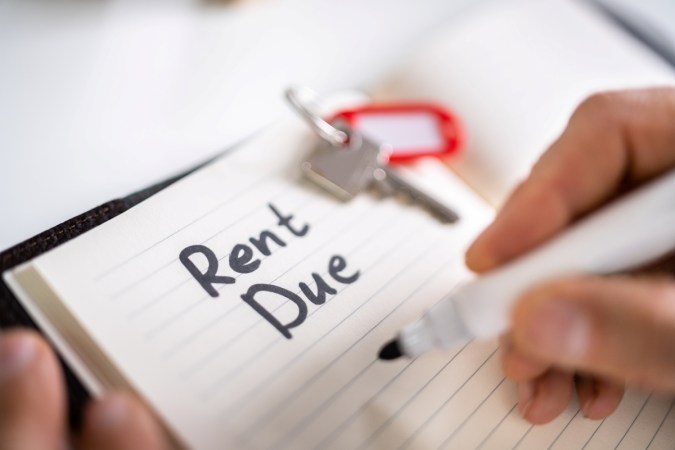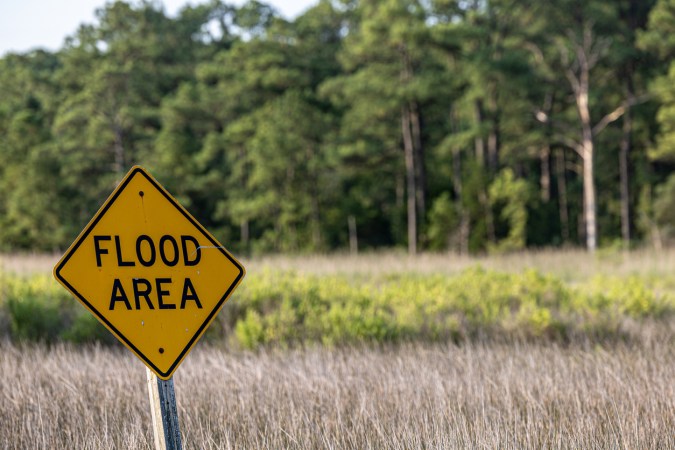We may earn revenue from the products available on this page and participate in affiliate programs. Learn More ›
Homeownership is a dream for many—owning a home provides a sense of freedom for the owner to make their home their own through DIY projects, professional home improvement projects, and personalized decor. The one drawback of homeownership is that your home can’t come with you on vacation—unless you own an RV. And for some, an RV isn’t just a vehicle— it’s a home on the road, lived in for months at a time.
Whether someone wants to travel full-time or is looking for mobile vacation lodging, an RV offers them the freedom to explore the country in a familiar and comfortable setting. However, the relatively high cost of an RV can make it difficult for new buyers to purchase the model they want up front. Luckily, there are many different RV financing options to help buyers purchase their dream home on wheels. Before they begin shopping, aspiring RV owners will want to learn how to finance an RV and how to get an RV loan that fits their budgets.
“To finance an RV, you have options like a bank, credit union, or RV dealership,” explains Eric Croak, certified financial planner and president of Croak Capital, a wealth management firm in Toledo, Ohio. “I always advise people to compare different financing options to find the best one for their needs. Look at the interest rate, length of the loan, and the monthly payments when making your choice.”
Before You Begin…
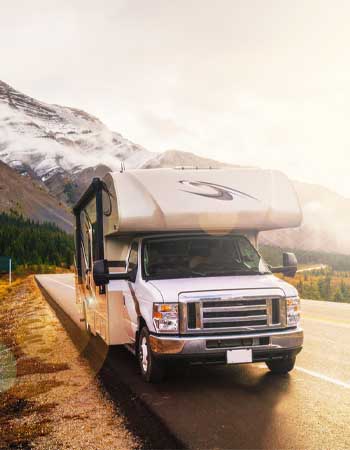
The purchase cost is only one of several expenses of RV ownership. RV shoppers will want to consider all of the RV costs and maintenance needs before financing an RV.
For example, a policy from one of the best RV insurance companies is often an afterthought for customers when purchasing an RV. However, RV insurance coverage is a must-have and is required by law, so shoppers will want to remember to leave room in their budget for RV insurance costs.
Other potentially overlooked expenses of owning an RV include regular vehicle maintenance, the cost of gas, and the cost of storage or parking when the RV isn’t in use. Additionally, some RV owners choose to upgrade the standard features of their RV, such as investing in one of the best RV mattresses for better sleep or upgrading their retractable awnings to a more durable and attractive fabric.
STEP 1: Determine a budget for your RV purchase.
Before applying for RV camper financing, shoppers will want to determine how much they’re willing to spend on an RV. The cost of an RV varies widely among vehicles. A brand-new, large luxury model, for example, might cost an RV buyer as much as $400,000. Smaller used models with few or no bells and whistles could be as little as $10,000—or potentially less. RV shoppers can look at their current income and expenses to come up with an amount they would be comfortable spending on an RV and could pay back without causing too much disruption to their everyday finances.
“Before you begin looking for an RV, I recommend determining how much you’re able to spend,” advises Croak. “Considering everything from the size and design to your budget and the maintenance—there’s a lot to weigh up when shopping for an RV. Do thorough research, ask plenty of questions, and then do some more research—this ensures you make a well-informed choice when you’re ready to purchase an RV.”
Much like when a home buyer is shopping for a home, an RV buyer may want to create a list of the features they require on an RV, as well as the features they would like to have but can live without. This gives them a better idea of how much an RV with their preferred features will cost, and whether it’ll fit in their budget.
STEP 2: Check your credit score.
An RV buyer’s credit score and overall financial profile are among the most important factors in securing an RV loan. In general, the higher a borrower’s credit score, the better RV loan rates they’ll be offered by a lender. A borrower with a low credit score may have their application denied and be unable to secure a loan to purchase their RV. It’s a good idea for an RV shopper to check their credit score before they start applying for RV loans. There isn’t a standard minimum credit score requirement for lenders when it comes to RV loans, so buyers can ask each lender for their specific requirements to see if they will qualify.
If a buyer’s score suggests they’ll have trouble qualifying for a loan, they may want to put off their RV purchase while they work on improving their credit score. Generally, the best way for someone to improve their credit score is to make consistent on-time payments on credit cards and loans. It’s also helpful to avoid racking up too much debt and increasing their credit utilization percentage. Depending on a person’s current credit score, it could take months, or even years, for these actions to make a significant impact.
STEP 3: Save for a down payment.
As with credit score requirements, different lenders may have different down payment requirements for RV financing. Some lenders, for example, may require a borrower to put forward between 10 percent and 20 percent of the purchase price as a down payment. On a more expensive RV, this down payment could add up to a significant amount of cash. For example, a buyer hoping to purchase a $100,000 RV with a 20 percent down payment would need to put down $20,000 in cash to secure their loan.
In addition to lender credit score requirements, which can affect interest rates, down payments can greatly affect the monthly loan payment and interest costs over the life of the loan. The more money a borrower puts down on their RV, the lower their RV monthly payment. For this reason, borrowers may want to save up as much as possible before buying their RV.
STEP 4: Decide on the best type of loan and compare lender terms and rates.
Once a borrower knows how much they plan to spend on an RV and have a down payment saved, they can look at their loan options. Typically, there are several ways to finance an RV, including:
- RV-specific loans through traditional lenders such as banks or online lenders
- Personal loans
- Home equity loans
- Home equity lines of credit (HELOC)
- Cash-out refinancing
- Dealership RV financing
RV buyers will want to shop around to find the best loan terms and RV financing rates. Interest rates on RV financing vary significantly between loan type, RV purchase price, and lender. Borrowers will want to be careful when comparing loan products to ensure they’re making an “apples to apples” comparison and getting the best loan for their needs.
For example, a loan with a shorter term may have a higher monthly payment but a lower interest rate than a loan with a longer term. This means that by the end of the loan, the borrower will have paid less overall in interest despite the higher monthly payment, which means they’ll ultimately pay less for the RV. In addition, a borrower’s credit profile and financial situation can impact their RV finance rates.
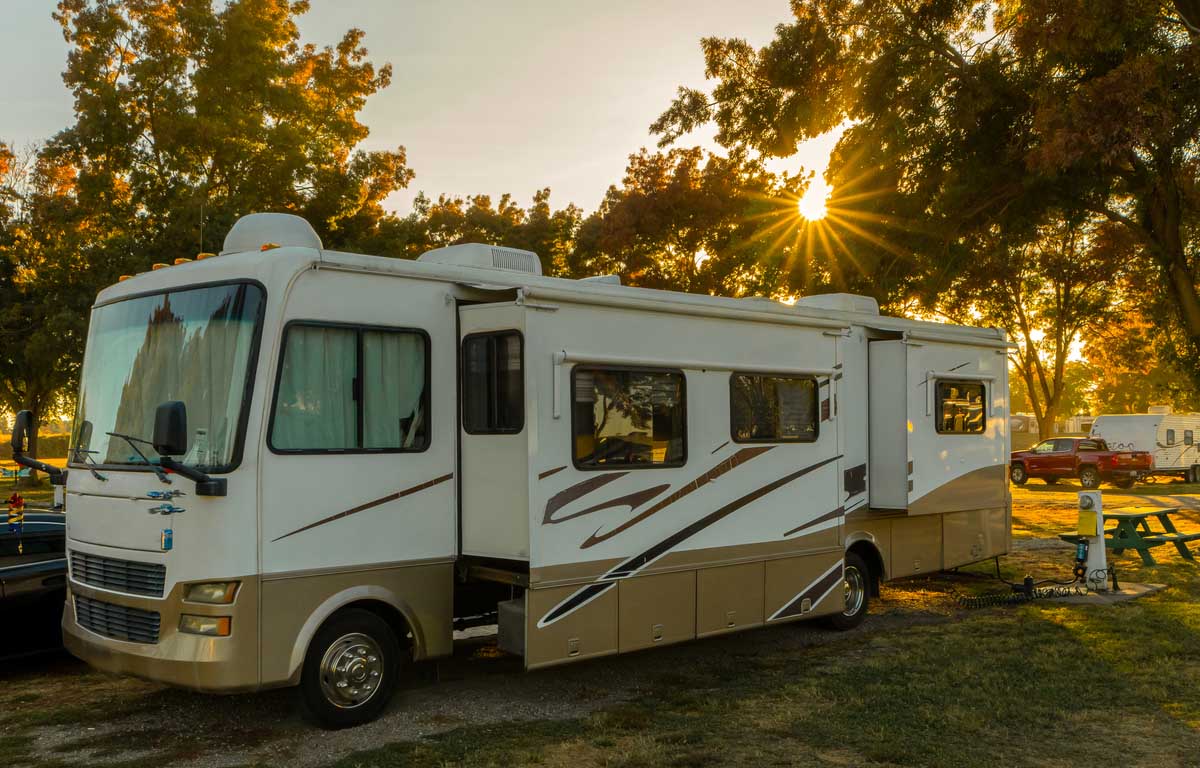
STEP 5: Look into RV loans through a traditional or online lender.
Many banks, credit unions, and online lenders offer RV financing for borrowers. Typically, traditional lenders will offer secured RV loans, which means the RV itself is used as collateral for the loan. If the borrower defaults on the loan, the bank can repossess the RV and sell it to recoup some of its costs. Traditional lenders also tend to have the strictest loan requirements, such as a higher minimum credit score or a lower debt-to-income ratio (the amount of debt the borrower owes in relation to their regular income).
Online lenders or those that specialize in RV financing may be able to offer borrowers more flexible lending requirements or terms. Bad credit RV loans, for example, may be available for borrowers with “fair” or “poor” credit scores. Nontraditional lenders may also offer unsecured RV loans, which don’t require collateral (though this will mean a much higher interest rate since there’s nothing for the lender to fall back on if the borrower defaults). Both traditional and online lenders often have a preapproval or prequalification process for borrowers, which helps them get a clearer picture of their total budget and monthly payment before they head to the dealership.
STEP 6: Consider a personal loan to finance your RV purchase.
Personal loans can generally be used for whatever the borrower wants—including the purchase of an RV. Most banks and other financial institutions offer personal loans for qualified borrowers. Personal loans are generally most practical for used or lower-value RV purchases. Many personal loan lenders have loan amount limits that are lower than other types of RV loans, which can limit the purchasing power of the borrower.
In addition, personal loan rates tend to be higher than those of other types of loans, especially for larger loan amounts, because they are unsecured. The higher average RV loan rates make personal loans less practical for purchasing a high-value RV. For instance, if a buyer wants to purchase a $150,000 RV with a personal loan but their bank only offers personal loans up to $50,000, the buyer would still need to cover the remaining $100,000 needed to buy the RV.
STEP 7: Determine whether a home equity loan is a good option for RV financing.
Thise with a certain amount of equity in their home may be able to use it to finance their RV purchase. A home equity loan is a type of term financing that uses the equity in a borrower’s home as collateral for the loan. The best home equity loans (such as one from U.S. Bank or Flagstar Bank) tend to have fixed interest rates, which means rates will stay the same for the life of the loan. Fixed interest rates help the borrower budget for their loan by knowing their exact monthly payment and how long it will take to repay the loan.
“If you have a house, using a home equity line of credit can be a good choice,” says Croak. “These usually have lower interest rates than RV loans, and they’re always less than credit card rates. But remember, your house is what you’re risking. If you don’t keep up with payments, you could lose your home.”
Borrowers considering a home equity loan may want to check with their lender about loan requirements. Most home equity lenders have loan amount limits and equity requirements when it comes to offering a home equity loan. For example, a lender may only offer loans up to 80 percent of the equity in a home. In this case, if a borrower has $100,000 in equity, they would qualify for up to $80,000 in financing.
STEP 8: Consider taking out a home equity line of credit (HELOC) to help pay for your RV.
Much like a home equity loan, a home equity line of credit (HELOC) uses the equity in a home to secure financing. The difference between loan types is that a home equity loan is a lump-sum loan with a fixed rate, while a HELOC is more like a credit card with a borrowing limit and a variable rate. Qualified homeowners will receive a credit limit based on the equity in their home. They can then choose to withdraw as much or as little from their line of credit as they like, up to their limit. Any money borrowed is paid back over time, plus interest. Opting for one of the best HELOC lenders means a borrower won’t take out more money from their home’s equity than they need to finance their RV.
STEP 9: Look into whether a cash-out refinance can help you with your RV purchase.
Another way for shoppers to use their home equity to finance an RV purchase is by opting for a cash-out refinance from one of the best mortgage refinance companies (such as PNC or Caliber Home Loans). Refinancing a mortgage replaces the original loan with a new one that typically has a shorter term or lower interest rate. If the homeowner has enough equity in their home, they can do what’s known as a cash-out refinance, where they refinance their home for more than they owe on their current mortgage and receive the difference as a lump-sum payment of cash that they can use to fund their RV purchase.
A cash-out refinance could be a good option, especially if the borrower’s original mortgage was taken out at a time when interest rates were high and current interest rates are much lower. The lower interest rate would mean a lower monthly mortgage payment, and using a cash-out refinance to purchase an RV means the borrower will only have one payment each month rather than two.
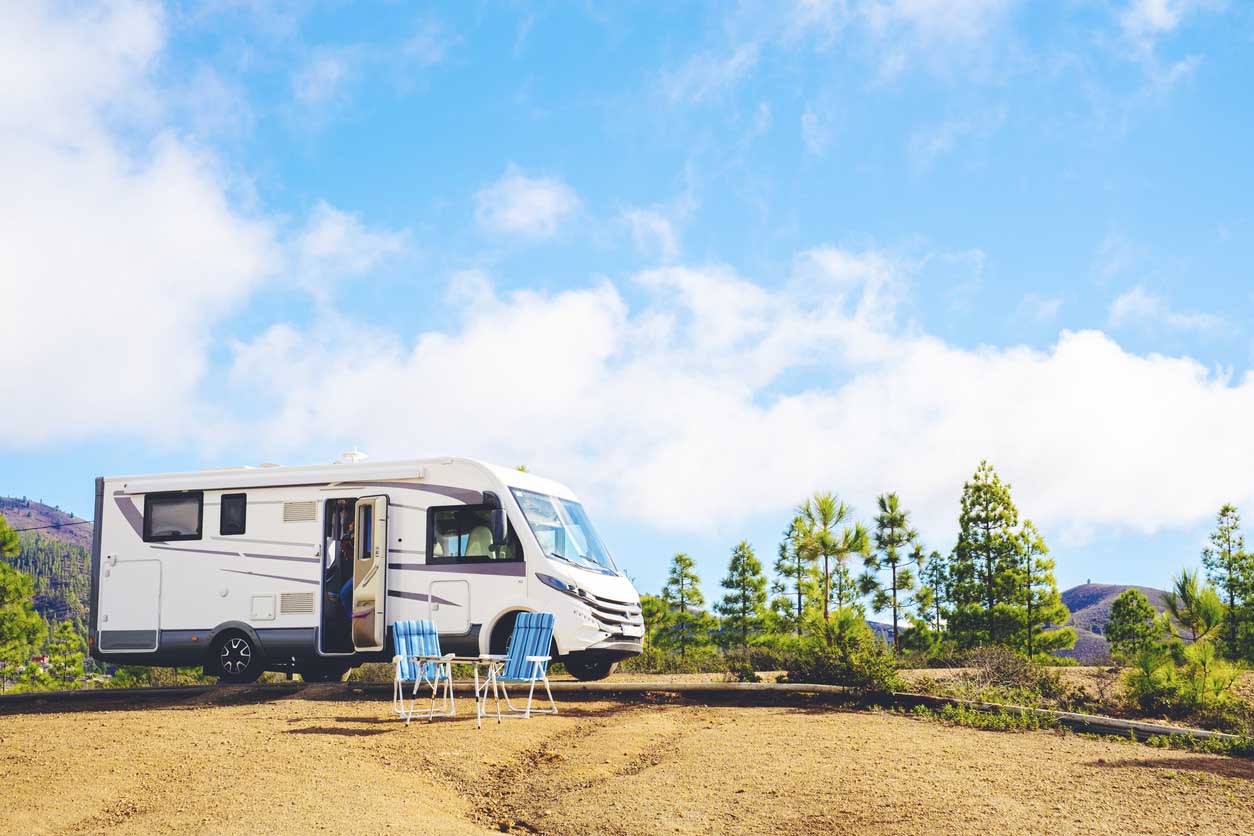
STEP 10: Check loan rates through the RV dealership.
Many RV dealerships offer financing on-site. Dealer financing can be a good RV financing option for buyers who want to make their purchasing process as simple as possible. Generally, buyers can apply for financing at the dealership after they select the RV they wish to purchase. Dealerships typically offer financing through in-house loans or partnerships with third-party lenders.
Getting a loan through the dealership may give the buyer more bargaining power in the transaction. Dealerships who offer financing often make money off the loan, so it’s in their interest to work with a buyer on a sale or risk the buyer choosing a different dealership for their RV purchase. Buyers who choose dealership financing may be able to adjust the purchase price of their RV or negotiate a more favorable interest rate on their loan. The downside to dealer financing, however, is that buyers may not qualify for the loan they need to get the RV they want.
STEP 11: Get prequalified with several lenders.
Prequalification is the process of getting an RV loan quote from a lender. Buyers might think of a prequalification as a soft application for a loan. While the process varies from one lender to another, it generally includes a lender looking over a potential borrower’s credit score and financial profile. If the applicant is qualified, the lender offers a loan quote that includes potential rates and fees. “Applying to multiple mortgage lenders lets you compare interest rates and fees, helping you find the best deal,” explains Croak. “In my experience, having more than one offer puts you in a stronger position to negotiate and get a better loan package.”
Borrowers will want to note that prequalifying for a loan doesn’t necessarily mean their application will be approved. While a prequalification generally indicates a lender would offer a borrower a loan, the loan terms may vary slightly from the original quote. With several prequalified RV loan quotes in hand, a borrower can narrow down their loan choices.
In most cases, a prequalification doesn’t affect a borrower’s credit score. Lenders typically use a “soft pull” on a borrower’s credit report when offering loan quotes. However, not all lenders use this method. Borrowers will want to ask each lender about what kind of credit inquiry they use and the effect on their credit score if it’s unclear.
STEP 12: Find an RV and submit the loan application.
Once a borrower has an RV budget, loan type, and prequalification in hand, they can officially start the shopping process. Similar to shopping for loans, it’s often a good idea for buyers to visit multiple RV dealerships before buying. Shopping around lets buyers look for the best price on the make and model of RV they want. Additionally, buyers may have more negotiation room with a dealer if they know another dealer has the same RV.
After finding the RV they want and negotiating a price, the buyer can submit an RV financing application. Many lenders approve new loan applications quickly, but some loan types may take longer than others to approve. Home equity loans and HELOCs, for example, may require extra steps to verify the equity on a borrower’s home. Meanwhile, most dealership-offered financing can be completed the same day that the borrower buys their RV. Loan applications generally ask for information about the borrower’s identity as well as their financial information, such as the name of their employer and proof of their income. If a lender approves the application, the borrower simply needs to review their loan terms and sign the agreement to secure the loan.
Finding an RV and securing financing is easy with these 12 steps. It’s recommended that borrowers shop around for the best type of loan, loan terms, and RV prices before they commit to a purchase. Additionally, borrowers may want to carefully consider their financial situation before purchasing an RV. Coming up with a defined budget and maximum monthly payment amount can help an RV buyer avoid taking out a larger loan than they can comfortably afford.

